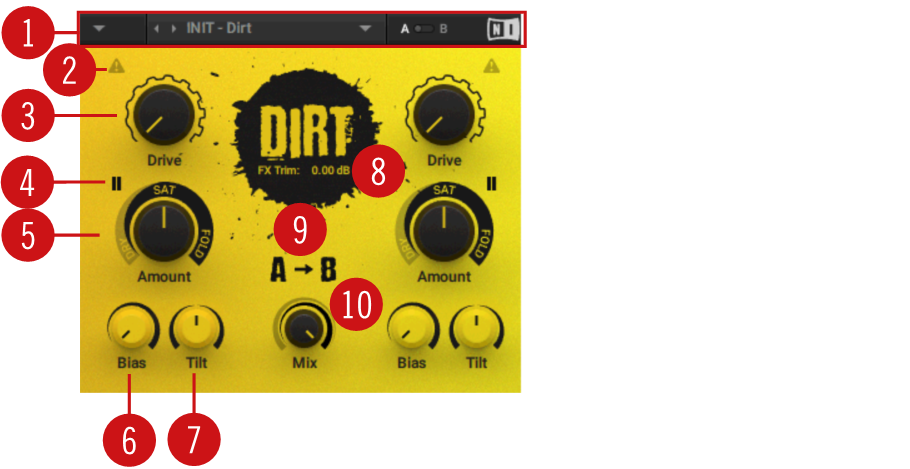DIRT
DIRT simulates the distortion created by analog circuits, which can be based on vacuum tubes or transistors. This section includes a note about distortion effects and an overview of the DIRT plug-in.
In this chapter you can learn about DIRT. It includes a general note about distortion effects and an overview of the DIRT plug-in.
About Distortion Effects
Distortion effects simulate the distortion created by analog circuits, which can be based on vacuum tubes or transistors. They add harmonic overtones to audio signals, usually by increasing their gain and clipping their contour, to produce a fuzzy, growling, or gritty sound.
Although they are often associated for use with electric guitar, they can also be used on other instruments or any audio signal to intentionally add warmth or distortion to a sound. Distortion adds harmonic or enharmonic overtones, which sound pleasing in small amounts (often called saturation), but can overtake sounds for intense or unnatural effects.
Distortion effects include controls for gain, which let you control how much the distortion alters the signal, and for tone, which let you shape the way the distortion alters the signal (by filtering). DIRT combines two distortion units, which additionally offer control over the type of clipping behavior.
Overview of DIRT
DIRT carefully provides more sophisticated and extreme sounds than possible with common distortion pedals, while staying true to the ease of use associated with these effects.
It consists of two circuit-modeled diode clipping stages (A, B) that can be configured in series or parallel using the Routing control. There are three modes of distortion (I, II, III) which can be used independently on each stage of the effect to set the type of clipping behavior. This allows you to explore different distortion characteristics and tonal qualities from subtle to more extreme.
The Drive control combined with the Amount control allow you to gradually increase the amount of saturation or distortion added to the signal. If the Amount control is increased beyond center position, the signal is folded back into itself, causing a more extreme distortion effect that adds strong harmonic overtones to the sound. By combining high settings for Drive and Amount on both stages, very rich and sustained sounds can be created by adding dirt and compression to the signal.
The distortion effect of each stage can be further adjusted using the Tilt control for filtering, and the Bias control for adding asymmetric behavior to the circuit, controlling the amount of even harmonics. Finally, when used in series the Mix control allows you to blend the dry and distorted signal to suit your mix, whereas in parallel mode the Blend control allows you to blend between the two stages A and B.

Header: Provides global functions related to preset management and plug-in behavior. For more information, refer to Header and Presets.
Safety (warning symbol): Switches off the gain compensation that keeps consistent loudness levels. This can be used, for example, to drive a signal into the second stage at higher distortion levels.
Drive: Adjusts the input level, or gain. Turning Drive to the right increases the intensity of the distortion.
Mode: Selects one of three distortion modes to be used independently on stage A and stage B:
I is the most subtle mode and adds the least amount of coloring to the audio signal.
II is the default mode and is a well-balanced type of distortion with the brightest tone.
III is the most extreme mode which adds a crushed type of distortion with a dark tone.
Amount: Adjusts the amount of distortion by introducing saturation in the first half of its range and wave folding in the second half. Instead of clipping the signal, wave folding folds the waveform of the signal back into itself.
Bias: Introduces asymmetry into the signal by adding asymmetric behavior to the circuit, which produces even harmonics. This prevents the distorted audio from sounding hollow.
Tilt: Applies filtering to the distorted signal. When turned to the right, low-frequency content is attenuated and high-frequency content is boosted. When turned to the left, low-frequency content is boosted and high-frequency content is attenuated.
FX Trim: Adjusts the output level of the wet signal in the range of -18 dB to +6 dB. This can be used to compensate for loudness differences between presets.
Routing: Determines how the signal is routed between stage A and stage B of the effect:
A > B serial routing configuration: The signal is fed into stage A, then into stage B.
A < B serial routing configuration: The signal is fed into stage B, then into stage A.
A + B parallel routing configuration: The signal is split into both stage A and stage B before being mixed with the Blend control.
Mix: Blends between the dry signal and the wet signal by means of an equal-power crossfade. In A + B parallel routing configuration Mix is replaced with the Blend control, allowing you to blend between the output signals of stage A and stage B.